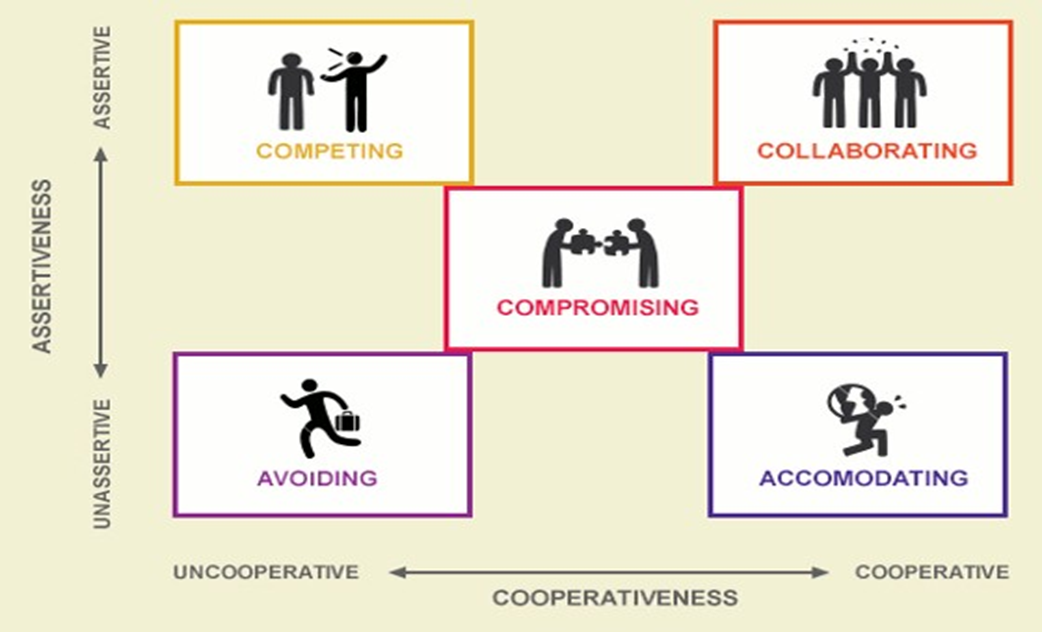“Whenever you conflict with someone, there is one factor that can make the difference between damaging your relationship and deepening it. That factor is attitude.” – William Jame.
Conflict resolution in the workplace can be a challenging task for any business leader. Navigating competing goals and opinions between employees and groups can be difficult, leaving many business professionals feeling overwhelmed by the situation. In order to ensure optimal outcomes, it is essential to approach conflict resolution with an understanding of underlying causes and sound strategies to manage it effectively.
This blog explores key organizational conflict management approaches, the negative impacts of workplace conflict, and ways to prevent conflict before it occurs. The goal is to provide business leaders with the knowledge necessary to act when confronting conflict among peers and staff.
What is workplace conflict resolution?
Conflict resolution addresses disagreements and finds common ground that enables everyone to work together peacefully.
What is workplace conflict?
Workplace conflicts happen when there are disagreements between co-workers, peers, or colleagues. These occur because individuals have opposing opinions, interests, or beliefs. Workplace conflict expresses itself in many ways, such as insults, noncooperation, bullying, reputation assassination, and resentment. Having conflicting ideas is a normal and even a healthy part of business life. However, sometimes arguments go too far and become personal attacks.
What causes workplace conflict?
The causes of workplace conflict can range from personality clashes and misunderstood communication to organizational mismanagement. Moreover, common causes of workplace conflict happen when there are opposing interests, incompatible work styles, competition for company resources, failure to follow company norms, poor communication, and performance deficiencies.
- 60% of employees never received basic conflict management classes or workplace conflict resolution training. (CPP Inc).
- 95% of employees that received conflict management training state that it helped them navigate workplace conflict positively and seek mutually beneficial outcomes (CPP Inc).
Business-related sources of conflict include: poor management, unfair or discriminatory treatment, inadequate training, lack of opportunities, unhealthy competition, changes to internal business systems, mergers, acquisitions, layoffs, or even an unintentional slight or annoying habit that rubs someone the wrong way.
What are some of the negative impacts of workplace conflict?
The adverse effects of workplace conflict can include work disruptions, decreased productivity, project failure, absenteeism, turnover, and terminations. Additional examples of the negative impact workplace conflict can have on an organization:
-
- Increases in employee complaints
- Toxic work environment
- Damage to the business’s reputation
Unresolved conflict, if left unchecked, can lead to workplace toxicity. In the long run, conflict may impact the company’s reputation, revenues, and reduced profits.
- $359 billion in paid hours, according to one study. That’s the total price of the 2.8 hours per week U.S. employees spend dealing with workplace conflict.
- In 2021, there were 61,331 workplace discrimination charges in the U.S., which resulted in more than $34 million in damages for victims in federal court.
Business owners and managers must realize the impact of conflict in the workplace and take the steps needed to remedy the situation before it escalates.
How can workplace conflict be resolved?
“Whenever you’re in conflict with someone, there is one factor that can make the difference between damaging your relationship and deepening it. That factor is attitude.” – William James.
The Thomas-Kilmann Instrument (TKI) is designed to gauge how people behave in conflict situations. Conflict situations refer to cases in which the concerns of two individuals are incompatible.
Figure 1: Thomas-Kilmann Instrument

(Figure 1: Source: SacredStructures)
In conflict situations, the TKI model expresses a person’s behavior along two dimensions:
-
- Assertiveness: the degree to which the person attempts to satisfy personal interests.
- Cooperativeness: the degree to which the person tries to resolve the other person’s concerns.
Five Approaches to Workplace Conflict Resolution
The TKI model provides managers and employees with an understanding of their default style of managing conflicting opinions, interests, or beliefs when they occur in professional environments. Further, knowledge of the different approaches will assist managers in dealing with each conflict resolution style/approach when it presents itself.
1. Competing approach: this is an assertive and uncooperative approach to managing conflict. When an individual applies this resolution style, they are not interested in the other person’s concerns or their mutual relationship. This is a power-oriented approach wherein the individual will use any means necessary to win. The concept of “competing” in the conflict resolution context implies fighting for one’s interests at all costs.
2. Accommodating approach: this approach is unassertive and cooperative, the opposite of the competing method. People who pursue accommodations do so at the expense of their own interests, intending to satisfy the concerns of the opposing party. Hence, there is an element of self-sacrifice in this mode. Accommodating can take the form of selfless generosity or charity, deference, or capitulation.
3. Avoiding approach: is unassertive and uncooperative—the person neither pursues their own interests nor those of the other individual. Thus he does not deal with the conflict. Avoiding can take the form of tactfully sidestepping a disagreement, postponing it until a better time presents itself. Or avoiding may mean withdrawing from a threat or the possibility of conflict.
4. Collaborating approach: is an assertive and cooperative approach; it is the opposite of avoiding. Collaborating involves making an effort to work with others to find solutions that are satisfactory to all parties. Collaboration means working through a problem to determine both individuals’ underlying needs and wants. Collaborating between two persons can explore a disagreement to learn from each other’s insights or find a creative solution to a mutual problem.
5. Compromising approach: is moderate in assertiveness and cooperativeness. This approach aims to find a suitable, mutually acceptable solution that satisfies both parties. Attempting to compromise falls between competing and accommodating. Compromising gives up more than competing but less than accommodating. Moreover, it addresses a problem more directly than avoiding it but does not explore it in depth. In some situations, compromising might mean splitting the difference between the two positions, making concessions, or seeking a quick middle-ground solution.
Tips on how to prevent conflict from arising
“When you realize you’ve made a mistake, make amends immediately. It’s easier to eat crow while it’s still warm.” – Dan Heist.
In order to create a healthy, harmonious environment where your company can thrive, workplace conflicts need to be defused as quickly as possible. Unfortunately, workplace conflict can manifest in many ways, including insults or bullying, aggression, refusal to cooperate, and ignoring or ghosting others.
Identifying Conflict: Body language such as avoiding eye contact, nervousness towards a person, and crossed arms are signs of defensiveness. Frowning or being socially withdrawn expresses discontent or the possibility of dissatisfaction. These are signs that indicate the possibility of organizational conflict.
Don’t Ignore the signs: unresolved conflict in the workplace causes stress, frustration, sleeplessness, poor temperament, illness, absenteeism, or other problems for individual employees. These symptoms require further investigation and resolution.
Active listening: listening skills are critical to understanding what people have to say. Listening to their perspective encourages them to listen to opposing views. Sometimes, individuals want to be heard and for their frustrations to be validated.
Simplify the complaint process: The complaint resolution process ensure that employee issues are brought to the attention of organizational leadership and are appropriately dealt with. In addition, proactively dealing with complaints is a powerful way to disarm conflict.
Clarify the anti-harassment and anti-bullying policy: Communicating the anti-bullying policy ensures that employees are treated fair and can work in a safe environment without fear of being harassed or bullied. Communication of these policies can act as a deterrent to conflict.
Managers must treat every complaint or disagreement seriously and conduct a thorough investigation to reach the fairest possible conclusion. Prevention aims to create an environment where employees feel listened to whenever they have concerns. Ignoring or mishandling complaints can have dire consequences for employees and the organization.
“Do not think of knocking out another person’s brain because he differs in opinion from you. It would be as rational to knock yourself on the head because you differ from yourself ten years ago.” – Horace Mann.
Conflict management is an important skill for any business professional. Understanding the root causes of conflict and utilizing effective strategies can help ensure that employee disagreements are resolved quickly and effectively. In order to create a productive and positive work environment, it is essential to have a clear plan for managing conflict.
Thank you for reading our article!
TimeWellScheduled.com is a secure online time and attendance software that is 100% tailored to meet your scheduling needs! In addition, TimeWellScheduled facilitates employee attendance tracking & payroll tasks and enhances staff management capabilities. Plus, our service is free for up to 10 employees!
Click: here to download our (Excel) employee scheduling template; I.T.’S FREE!





